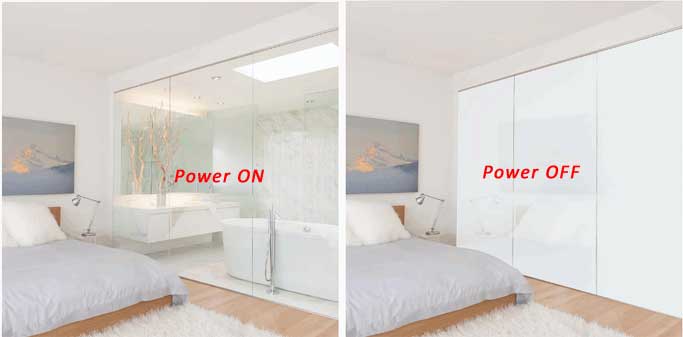Posted on : 08-04-2021 Author : Rani Dutta
Smart Glass Also known as dynamic glass, smart or switchable glass refers to a glass that changes the way it transmits light when heat, light, or voltage is applied to it. It changes from transparent to opaque (Like frosted glass) transparent vision and vice-versa by blocking or allowing some or all wavelengths of light to pass. This happens via a simple switch flip, hand wave, or an app tap. In other words, you get a dynamic glass area that can be kept open or private.
Types of Smart Glasses
The ‘smart glass’ term encompasses active technologies in which the glass coatings and films change the appearance after being activated by an electrical charge. Keeping this in mind, two main types of smart or switchable glass exist namely, active and passive. If the change in functionality of the glass occurs due to an electrical charge, it is an active smart glass. Or else, it is a passive smart glass.
Technologies behind Smart Glass
The technologies that quickly switch the state of a glass surface from transparent to opaque and vice-versa are collectively called privacy glass technologies. Following are the three types of active smart glass technologies:
- Electrochromic: This technology filters the heat and light of the sun. It utilizes two electrodes to push ionized particles from within the transparent glass to outside to render the opaque look. After this movement, no current is needed to retain them at the current state. As a result, the transition time is more with the increasing glass size. This kind of glass cannot become fully opaque, and hence, is preferable for exterior uses such as energy-conserving windows.
- Polymer Dispersed Liquid Crystal (PDLC): This technology contains liquid crystals that have traits of solid as well as liquid compounds, which are diffused in a polymer. The layer of crystals exists between two clear layers and are randomly organized due to which light scatters at the time of passing to create a white look. In opaque mode, it is suitable for whiteboard use and privacy. It also allows glass windows and walls to act as a transparent area or a projection screen quickly. In windows, PDLC restricts visible light. As available in different colors and patterns, PDLC is suitable for several indoor and outdoor industrial applications using new or existing glass.
- Suspended Particle Device (SPD): This technology has tiny solid particles poised in liquid and coated between the thin layers of PET coated with ITO to make a film. It cools and glooms the interior by impeding most of the incoming light in a few seconds of changing the voltage. Just as with PDLC, you can dim the appearance for a tailored shading experience. However, unlike PDLC, you cannot expect a totally opaque look. Thus, it is not suitable for private zones. Rather, it is ideal for windows facing the sky, water, or surrounding exterior area. You can even use this type of smart glass where darkness is the top priority, for example, in cars or some areas of buildings.
Active smart glass technologies run automatically using controllers or transformers via manual operation or scheduling. Unlike transformers that change glass only to opaque, controllers utilize dimmers to slowly change both voltage and light to different levels. Following are the two types of passive smart glass technologies.
- Thermochromic: This technology becomes translucent on the application of heat. It occurs when the external temperature goes beyond the transition temperature, which kindles the glass’ thermochromic filter. This activation transitions the tint in a few minutes. This kind of glass works by blocking light, glare, and heat while providing clear views.
- Photochromic: This technology also works by transmitting light after being affected by an external source; it is usually UV radiation but any light of adequate intensity can activate it. Nevertheless, unlike electrochromic glass, the clarity changes when the source of light changes. Such glasses are mostly used in optical lenses.
Applications
Smart glass is used to control privacy, heat, and light in homes, offices, and establishments such as restaurants and hospitals. It renders a cleaner environment and more as well as distinguished levels of control than the manual alternatives such as shades, blinds, doors, and curtains.
Smart or switchable glass is integrated into transparent surfaces such as partitions and windows. It is used in different sectors, including automotive, interior design, and consumer electronics. This glass is specifically popular for partitioned or glass-walled conference rooms in lively workspaces and hotel guestrooms where restricted space and conventional curtains do not contribute to aesthetics.
